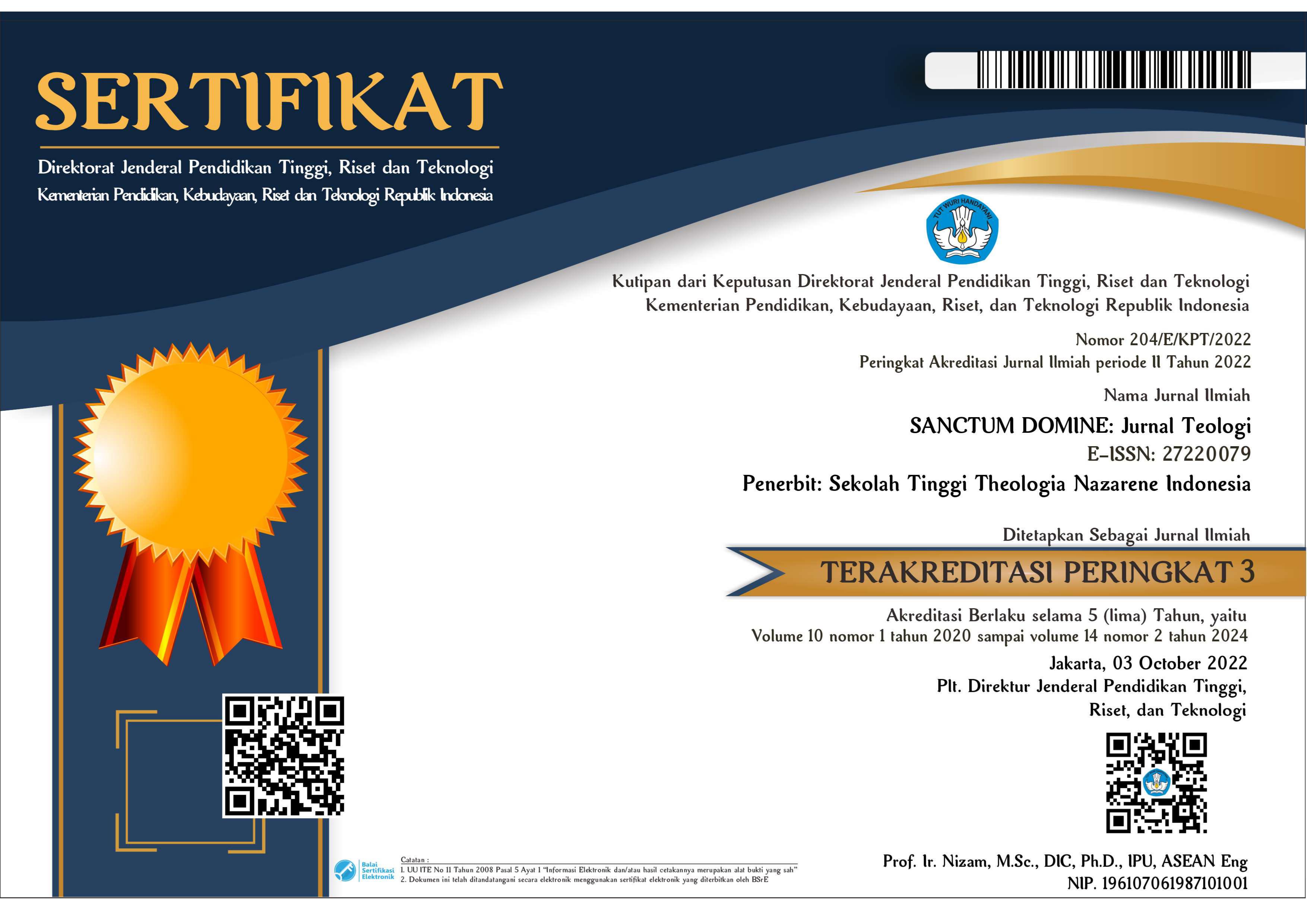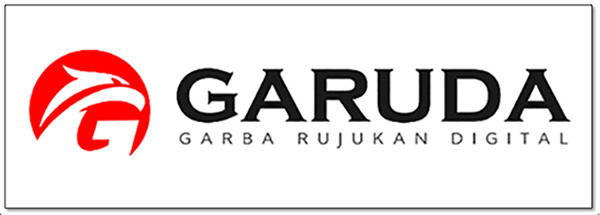Studi Onomastika Biblikal dalam Sejarah Linguistik Penulisan Teks Perjanjian Baru
Abstract
This article examines the proper names in the New Testamment including the study of those etymologies and terminologies. The study in this article is related to the linguistic history in Miditeranian sea surrounding areasthat have become the writting locus of New Testamment original text. The discussion has been conducted with linguistic and historical approaches in both biblical and geographical context. From the research that has been undergone, there is an important fact that there was a language development history in the area arround Miditeranian sea. The usage of Greek language as the language of New Testament is strongly connected to the history of the Greece in that area. The names in New Testamment show that there were various languages that had been existed and used in NT written locus. NT reports that there are various names from several different languages related to the history of that area such as Hebrew, Aramic, Latin and Greek.
References
Bauckham, Richard dan lainnya Jews With Latin Names in the New Testament dalam Paul, Luke and the Graeco-Roman World: Essays in Honour of Alexander J.M. Wedderburn, disunting oleh Alf Christophersen dan lainnya.. New York : T&T Clark International, 2003.
Bellinzoni, Arthur J. The New Testament: An Introduction to Biblical Scholarship. Eugene, Oregon: Wipf&Stock 2016.
Burke, Kenneth. Language as Simbolic Action: Essay on Life, Literature, and Method. London, Inggris: Cambridge University Press, 1996.
Clackson, James, dkk. The Blackwell History of the Latin Language. Malden, MA: Blackwell, 2007.
Clackson, James. “Latin” dalam The Cambrige Encyclopedia of the World’s Ancient Languages. ed. Woodard, Cambrige: Cambrige University Press, 2004.
Crawford, Osbert Guy Stanhope. Antiquity: A Quarterly Review of Archaeology, volume 26-28, Antiquity Publications: 1964.
Everett Ferguson, Backgrounds of Early Christian, volume 3, Grand Rapids, Michigan: William B. Eerdmans Publishing Company, 2003.
Gzella, Holger. A Cultural History of Aramaic: From the Beginnings to the Advent of Islam, Leiden: Koninklijke Brill, 1974.
Heer, J.J. de, P.S. Naipospos, Nama-nama Pribadi di dalam Alkitab, Jakarta: BPK Gunung Mulia, 2008.
Hoyos, Dexter. Rome Victorious: The Irresistible Rise of the Roman Empire, New York: I. B. Tauris & Co., 2019.
Jatmiko, Bakhoh. Bahasa Asli Kitab Perjanjian Baru. Kajian Historis-Linguistik Terhadap Aramaic Primacy Theory dalam SANCTUM DOMINE: Jurnal Teologi, Volume 2, Nomor 1, Yogyakarta: Sekolah Tinggi Theologia Nazarene Indonesia, 2015.
Jeffers, James S. The Greco-Roman World of the New Testament Era: Exploring the Backgrounds of Early Christianity, volume 3, Downers Grove: InterVarsity Press, 2009.
____________. The Greco-Roman World of the New Testament Era: Exploring the Background of Early Christianity, Downers Grove: InterVarsity Press, 1999.
Lerner, Jeffrey D. "Seleucids" dalam The Oxford Encyclopedia of Ancient Greece and Rome, volume 2, disunting oleh Michael Gagarin, New York: Oxford University Press, 2010.
Longman, Tremper III dan Mark L. Strauss, "Aramaic" dalam The Baker Compact Dictionary of Biblical Studies, Grand Rapids, Michigan: 2018.
Matyszak, Philip. The Roman Empire, London: Oneworld Publications, 2014.
Meyers, Carol dan lainnya. “Priscilla” dalam Women in Scripture: A Dictionary of Named and Unnamed Women in the Bible, the Apocryphal/Deuterocanonical Books, and the New Testament, Grand Rapids, Michigan: William B. Eerdmans Publishing Company, 2001.
Ong, Hughson T. The Multilingual Jesus and the Sociolinguistic World of the New Testament, Leiden, Boston: Brill, 2015.
Parker, Robert. Theophoric Names and the History of Greek Religion, Proceedings of British Academy. The British Academy: 2000.
Poirier, John C. The Linguistic Situation in Jewish Palestine in Late Antiquity dalam The Journal of Greco-Roman Christianity and Judaism. JGRChJ.
Porter, Stanley E. The Languageof the New Testament: Classic Essays, JSNT Sup 60; Sheffield: JSOT Press, 1991.
Shakespeare, William. Shakespeare's Plays: With His Life, Volume 3, disunting oleh Gulian Crommelin Verplanck. New York: Harper & Brothers, 1847 didigitalkan 3 Jan 2007.
Tov, Emmanuel. Rivised List of the Text from Judean Desert, Leiden: Brill, 2010.
Albert C. Baugh dan Thomas Cable, A History of English Language, Upper Saddle River, NY: Prentice-Hall, 1984.
Weaton, Litah D. H. “Sergius Paulus” dalam Ensiklopledi Alkitab Masa Kini, volume 2, diterjemahkan oleh M. H. Simanungkalit., disunting oleh H. A. Oppusunggu, Jakarta: Yayasan Bina Kasih, 2003.
http://www.deadseascrolls.org.il/home
http://www.jewish-language.org/jewish-aramaic.html
https://www.biblestudytools.com/dictionary/joseph-barsabbas/
https://www.britannica.com/topic/Aramaic-language
https://www.kbbi.web.id/onomastika
https://www.wordsearchbible.com/products
Copyright (c) 2020 SANCTUM DOMINE: JURNAL TEOLOGI

This work is licensed under a Creative Commons Attribution-NonCommercial-ShareAlike 4.0 International License.
Copyright:
SANCTUM DOMINE: Jurnal Teologi will validate, produce, disseminate, and act as steward in the long-term curation of every article published. In order to achieve this, the author typically requires a transfer or “assignment” of the copyright in the article. As is the case for open access publishing, the author (or copyright owner of the article, if different) signs an author publishing agreement. The agreement incorporates the necessary transfer of copyright.
After assigning copyright, the author will still retain the right to:
- Be credited as the author of the article.
- Own and exercise any trademark or patent rights held by author and addressed in the article.
- Make printed copies of the article to use for a lecture or class that the author leading on a non-commercial basis.
- Share the article with friends, colleagues and influential people the author would like to read the work.
- Present the article at a meeting or conference and distribute printed copies of the article on a non-commercial basis.
License:
This work is licensed under a Creative Commons Attribution-NonCommercial-ShareAlike 4.0 International License.
You are free to:
- Share — copy and redistribute the material in any medium or format
- Adapt — remix, transform, and build upon the material
- The licensor cannot revoke these freedoms as long as you follow the license terms.
Under the following terms:
- Attribution — You must give appropriate credit , provide a link to the license, and indicate if changes were made . You may do so in any reasonable manner, but not in any way that suggests the licensor endorses you or your use.
- NonCommercial — You may not use the material for commercial purposes .
- ShareAlike — If you remix, transform, or build upon the material, you must distribute your contributions under the same license as the original.
- No additional restrictions — You may not apply legal terms or technological measures that legally restrict others from doing anything the license permits.
Notices:
You do not have to comply with the license for elements of the material in the public domain or where your use is permitted by an applicable exception or limitation .
No warranties are given. The license may not give you all of the permissions necessary for your intended use. For example, other rights such as publicity, privacy, or moral rights may limit how you use the material.




8.png)









